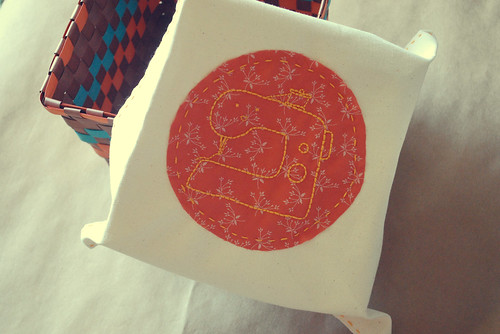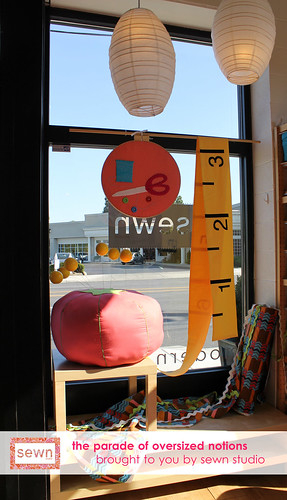Today I welcome Julie, the owner of the beautiful boutique sewing store Sewn Studio, and she is sharing her knowledge about what to look for when buying your first sewing machine.
Thanks to Ros for inviting me (and sewn studio) to be a part of her Back to Sewing Basics series. As the owner of an independent fabric shop, I have the pleasure of guiding many new sewists through the process of buying their first sewing machine and I'm glad to be here today to share that advice with you.
You want to buy a sewing machine. Maybe this will be your very first machine, or maybe you’re ready for an upgrade. Either way, it’s a major purchase. The right machine can make you feel like you can sew anything. The wrong machine can make you give it up for good. A little research, and knowing who you are as a sewist, can lead to the right machine for you.
Image Credit: Sewing machine embroidery by Mollie Johanson of Wild Olive.
Free embroidery pattern here.
Sewing machine manufacturers make two groups of machines: those that will be sold only through authorized dealers, and those that will be sold by retailers. Machines made to be sold by authorized dealers are generally heavier and start at a higher price point. If you can afford to spend a little more to buy a machine from a dealer, you’ll usually receive individualized attention before and after the sale and will end up with a great machine.
If you’re on a smaller budget, buying a machine from a retailer (stores like Target, Walmart, and Amazon.com, and in Australia, stores like Spotlight) can be equally successful – if you know what you want. Major retailers are unlikely to provide assistance in choosing a machine. If you follow these simple guidelines, you’ll end up with a machine you’ll love.
Know who you are as a sewist. Think about how you work and what you’re likely to sew. Will you be decorating a home? Making children’s clothing? Quilting? Your projects may change as you develop and change as a sewist, but you likely know yourself well enough to make a pretty good guess. Knowing your individual style will help you decide what features are most important to you.
Look for flexibility where it matters. Most machines on the market today have decorative stitches. It’s the selling point on many machines. “80 Built-In Decorative Stitches!” Fancy stitches can be fun, but a variety of choices in other options may be more useful. When buying a machine, I look for flexibility in both stitch length and width. I like these attributes to be independently adjustable and have the widest range possible. A stitch length range of 0-5mm and a width range of 0-7mm are good examples. The ability to adjust them independently allows for the greatest number of combinations.
Multiple needle positions lead to better accuracy. We all want our seams to be straight. We accomplish this with practice, and by lining the edge of the fabric up with a visual mark on the machine. Many sewists use the edge of the presser foot, others use the lines on the needle plate. Whatever you choose, your accuracy improves with practice. The ability to move the needle position – left, right, or center – allows you to adjust the seam allowance without changing your visual guide. I look for the maximum number of needle positions – a needle that can be to the far left, the far right, or any point in between.
Drop-in, or front-loading bobbin? Sometimes the answer to this is as easy as asking: “What are you used to?” We often prefer the bobbin style we learned first, or have the most experience using. If you are an experienced sewist, then you likely already know what kind of bobbin you want. But, if you are new to sewing, you may not even realize there’s a choice. Here’s a good rule of thumb: When in doubt, choose a drop-in or horizontal bobbin. Generally these are easier to learn. This doesn’t mean they’re better, just less frustrating to learn to use. These are the bobbins that you can see sitting below a clear plastic door slightly in front of the presser foot. Since any frustration is likely to decrease your love for sewing – avoiding it when possible is a good idea.
Additional Features: Sewing machine “packages” will vary greatly. You may see the same machine in two different stores, with completely different sets of accessories. Shop around and read the fine print. Compare machine features and the extras that come with the machine. Some features such as: speed control, automatic button hole, and specialty presser feet may make a machine a “better” deal. There are very user-friendly sewing machines on the market today – many for less than $200.
With careful thought, you can choose the right machine to help you create wonderful projects for years to come. Thanks again to Ros for having me here today, and make sure you drop by the sewn studio blog to say hello!
Julie
Thanks so much Julie - great information there and I certainly wish I knew a few more of those points before I bought my machine! I love my machine but I think I would have chosen more carefully had I been more knowledgeable about the different features.
For those of you lucky enough to live in or near Cincinnati Ohio, make sure you pop in and visit Sewn Studio! Otherwise you can check out their website, blog, and find them on facebook, twitter and pinterest.
Thanks so much Julie - great information there and I certainly wish I knew a few more of those points before I bought my machine! I love my machine but I think I would have chosen more carefully had I been more knowledgeable about the different features.
For those of you lucky enough to live in or near Cincinnati Ohio, make sure you pop in and visit Sewn Studio! Otherwise you can check out their website, blog, and find them on facebook, twitter and pinterest.




One thing I wish I had understood before I shopped for my first machine is that there are mechanical machines (like the old Singers and even Pfaff) and there are computerized machines. I love, love, love the needle down function available in computerized machines, i.e. you can choose to select your needle stop while it is down in the fabric. For me, this is worth paying for as you use it almost as much as the stitching function itself!
ReplyDeleteOn the other hand, lots of folks these days are picking up old mechanical machines at Goodwill or thrift shops. Most will allow you return the machine within a couple of days so you have an opportunity to try it out to ensure it works and/or to take it to a professional who can tell you if it is in working condition. These can be great inexpensive starters and then wonderful traveling machines. I use my mechanical machine for hauling around when I go on the road to stitch and for the most part I keep my more expensive computerized machine at home. Good luck all & sewing is tons of fun.
All good advice. I think sometimes people look at the number of decorative stitches, when in reality, for someone sewing mainly clothes, they'll rarely, if ever, be used. My first machine only had two stitches: straight and zig zag, but there was a lot of play with the stitch length and width. I used that machine for 20+ years.
ReplyDeleteGreat advice for both beginners and those (like me) who are looking to upgrade!
ReplyDeleteThanks so much Julie :) I'll be sure to share this with my readers too!
In addition to the above, test drive! Take the type of fabrics you normally sew or are interested in sewing with you. Don't be hurried by the sales staff and you should not feel intimidated. If buying used, learn the machine's history from the current owner. Thread the machine, check the lighting. If buying from a dealer, chat with them to see how comfortable you are with the staff, you are buying the dealership as well as a machine.
ReplyDeleteI totally agree about buying the dealership! I always go to the same place to have my machines serviced and to buy special needles. The ladies there are wonderful, always willing to help and importantly, try machines and give lessons. All machine dealers should be like this (and if not, go elsewhere!)
DeleteThanks for this!! I'm buying my first sewing machine am finding it a bit overwhelming! Great tips for what matters :)
ReplyDeleteThanks for this!! I'm buying my first sewing machine am finding it a bit overwhelming! Great tips for what matters :)
ReplyDeleteI was hoping to find some used sewing machines in Florida, it's more of a hobby than something I find myself doing often.
ReplyDelete